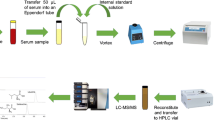Summary
Propafenone (PPF) is a new antiarrhythmic agent with structural features in common with the class of beta-blocking drugs (phenoxypropanolamines). Because of its high lipophilicity, the drug is strongly retained in reverse phase (RP) columns and simultaneous determination with the main polar metabolites 5-OH-PPF, N-depropyl-PPF and 5-OH-4-methoxy-PPF requires long run times (up to 50 min.)
Oxidative metabolism in vivo often produces derivatives whose higher polarity results from the addition of a polar group and/or the subtraction of an apolar one. These metabolites show similar chromatographic behaviour in RP mode and the trade-off between their separation and the sensitivity of the parent compound must be investigated. In an effort to shorten the run time we examined the retention of these early eluting substances as a function of different amine additives, pH and organic content in mobile phase using C8 and C-18 columns from different sources, previously characterized for their free silanophilic and hydrophobic activities. Under optimal conditions the run time was reduced to 14 minutes and an application of the optimized method to the determination in plasma samples of the drug and its main metabolites after chronic therapy with PPF is presented. To investigate possible coelution of other yet undiscovered metabolites which could accumulate in some patients under chronic treatment, the analysis was carried out using an electrochemical detection in parallel with the UV. Agreement was found between the two detection procedures and suggest no interference.
Similar content being viewed by others
References
R. P. Koshakji, A. J. J. Wood, J. Pharm. Sci.,75 87 (1986).
H. F. Proeiss, T. B. Townsend, Clin. Chem.,32, 1311 (1986).
O. A. G. J. Van Der Houwen, R. H. A. Sorel, H. Hilshoff, J. Teewsen, A. W. M. Indemans, J. Chromatogr.,209, 393 (1981).
R. E. Kates, Y. G. Yee, R. A. Winkle, Clin. Pharmacol. Ther.37, 610 (1985).
G. von Philipsborn, J. Gries, H. P. Hofman, H. Kreiskott, R. Kretzshmar, C. D. Muller, M. Raschak, J. Teschendorf, Arzneimittel-forsch/Drug. Res.34 (II), 1489 (1984).
E. Brode, Knoll Internal Reports (personal communication).
M. J. Walters, accepted for publication in JAOAC.
K. E. Bij, C. Horvath, W. R. Melander, A. Nahum, J. Chromatogr.,201, 65 (1981).
D. D. Blevins, Proceedings of the Third Annual International Symposium on “Sample Preparation and Isolation Using Bonded Silicas”, Cherry Hill, May 5–6 (1986).
A. Sokolowski, K. G. Wahlund, J. Chromatogr.,189, 299 (1980).
Author information
Authors and Affiliations
Rights and permissions
About this article
Cite this article
Marchesini, B., Tomasi, L. Effects of modifiers on the chromatographic behaviour of propafenone and its major metabolites. Chromatographia 24, 753–758 (1987). https://doi.org/10.1007/BF02688580
Received:
Revised:
Accepted:
Issue Date:
DOI: https://doi.org/10.1007/BF02688580




